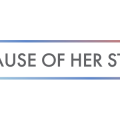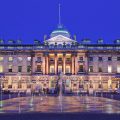For Carolyn Royston, fusing the digital with the physical is the future of museums
Carolyn Royston is Chief Experience Officer at Cooper Hewitt, Smithsonian Design Museum.
Before joining Cooper Hewitt in 2018, Carolyn Royston was the Director of Digital at the Isabella Stewart Gardner Museum in Boston. There, she led the launch of an award-winning website and initiatives to improve the visitor experience.
In 2017, she participated as a Fellow in the Getty Leadership Institute (GLI). She was also President of MCN (Museum Computer Network), a not-for-profit organization representing a wide range of information professionals from cultural sector institutions around the world.
As Head of Digital at Imperial War Museums in the United Kingdom from 2009-2014, Royston was responsible for all public-facing digital outputs across five museum sites. Before that, she was Project Director of the National Museums Online Learning Project, a flagship UK project led by the Victoria & Albert Museum.
Writer Lalla Merlin caught up with Royston to learn more about the innovative thought she is bringing to Cooper Hewitt as Chief Experience Officer, a role that fuses the digital and physical to create an integrated museum visitor experience.
Early career
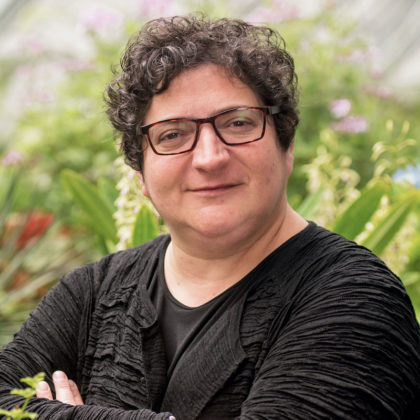
Carolyn Royston, Chief Experience Officer, Cooper Hewitt, Smithsonian Design Museum
Carolyn Royston’s route into the digital space was unorthodox.
“I used to be a primary school teacher. I was living in the UK and had a friend who was working in a digital agency. One of their clients was Cadbury’s Chocolate, in the early 2000s. Cadbury’s were interested in getting into schools and providing curriculum-based resources. My friend asked if I could help with the content, which I did.
“The agency then won a contract to do something similar for British Bakeries, and I helped them with that. Then they said, ‘Why don’t you just come and work for us?’ I decided that it would be interesting. I’ve always been interested in computers. Not only from a technology perspective, but just watching kids in the classroom, and how they react.
“These were the days where it was one computer in the corner of the classroom. I had really become interested in this new form of content delivery. As well as the different ways that it could be adapted for different kinds of learning styles. I was definitely coming at it from an education perspective.”
Digitization projects
“At the same time, there was also a big drive in the UK to do digitization projects in the cultural sector,” she continues. “I became interested in the opportunities around digital collections, which was still a very new idea, and the ways that they could be used. Particularly in education.”
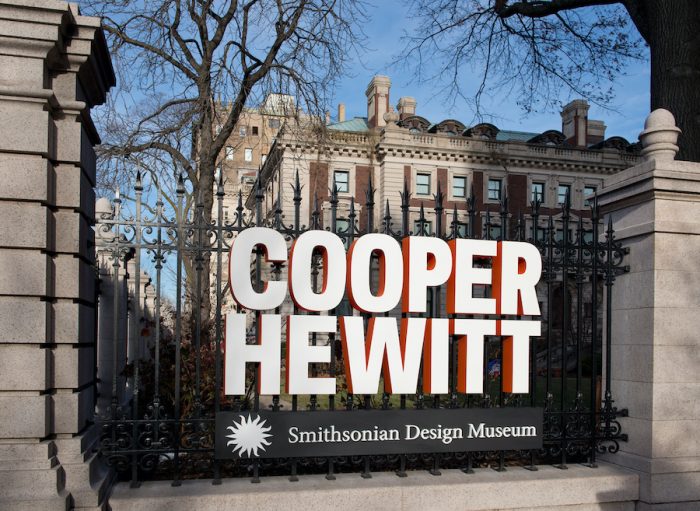
Cooper Hewitt, Smithsonian Design Museum, New York City. Photo by Matt Flynn © 2014 Cooper Hewitt, Smithsonian Design Museum
After working on several projects, Royston left the agency world for the museum sector, leading a flagship project, the National Museums Online Learning Project. Led by the V&A, the project involved working with nine national museums in the UK.
When that three-year funded project ended, Royston moved on to the Imperial War Museum where she spent more than five years as the museum’s first digital director.
“We had a major role in the First World War centenary and built up a digital program,” Royston says. This included putting the collections online, as well as creating a new website, new interactive experiences in the galleries and a presence on social media.
As a result, she became interested in the skills that museum staff were going to need going forward: “These were in terms of confidence around using digital in their work, building their digital skills, and understanding what skills needed to come into the museum, and what kinds of new professional development were going to be required.
Digital transformation and the museum sector
Royston began to see that her experience at the IWM of having to meet this challenge was being replicated almost universally across the museum sector.
She had been developing a network in the US and was also regularly invited to conferences and as a speaker at events. Through those connections, she was contacted by the Isabella Stewart Gardner Museum in Boston and asked to become the museum’s first director of digital.
“I was there for just over two years, then this opportunity at Cooper Hewitt came up.” Royston says. “Over the course of my career I had realized that, because of the route that had brought me into it, I have never come at it from a technology perspective.
“I was interested in thinking beyond digital, and also increasingly about how digital fits into an organization. Both in terms of the entire visitor experience and also from an organizational structure perspective.”
A new role at Cooper Hewitt
“But working in digital in museums, you’re involved in every single aspect of museum activity, every area, ” Royston continues. “It is very challenging when you’re in a department that’s at the side, or is just one department of many, when actually you’re one of the few people in a museum who is looking across the whole experience.
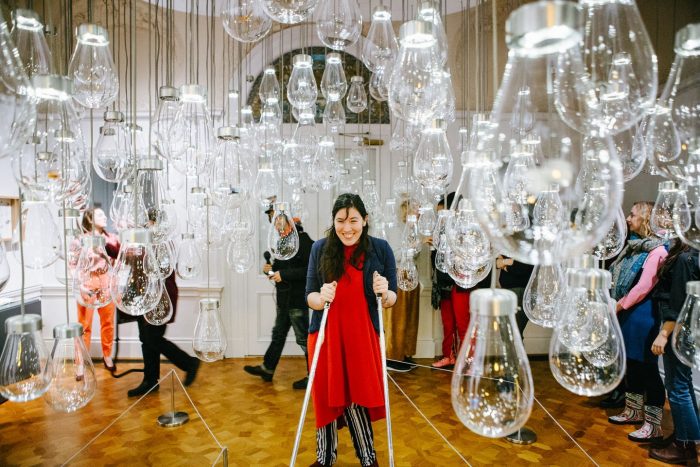
A participant in an Interaction Lab “Bodystorming” session at Cooper Hewitt, Smithsonian Design Museum. (Photo courtesy Cooper Hewitt)
“[Cooper Hewitt] was looking for another Director of Digital. [but] I wanted to expand my mission, my role. This meant actively removing ‘digital’ from my title, to make it Chief Experience Officer.”
“[I am] concerned with thinking about the experience across both the physical and digital spaces. And also the human interaction space. It is about looking at how those areas work across an entire visitor journey. Looking at the touchpoints, and at the responses or interventions as a museum that we need to make across those touchpoints, to make it a more holistic and seamless experience.
Digital literacy
The question of digital literacy has been one of the constants throughout Royston’s career.
“And it still is,” she says. “When I left the Imperial War Museum after having that experience of thinking around how we increase digital literacy for our staff, how we make them feel more confident, how we get to a place where they’re embedding digital in their work naturally rather than it being an add-on, I realized it cannot be the responsibility of a digital team to educate the entire museum staff.
“I was a teacher. So I had a sense of how people learn, but no one else on my team came from that background.”
There is an expectation that suddenly a whole area of critical professional development should fall on a group of technologists.
“Yet there is an expectation that suddenly a whole area of critical professional development should fall on a group of technologists. People who are not trained to teach. They have not signed up to be trainers. That realization made me curious about what we need to do to address this issue. It is a universal museum challenge.”
It is not, Royston says, simply a question of skills:
“It is about leadership understanding and leadership change around key strategic areas of museum development.
“If, as a museum director, you don’t really understand or know how to ask questions about technology, then you’re unlikely to make informed decisions about what technology directions you should be taking as an institution.”
“This concerns anything from investment in IT infrastructure to the gallery visitor experience, to the website. The irony, bringing it right back to today, is that the pandemic is highlighting exactly why it’s important. Because we’ve all had to pivot to this digital environment.
“The museums that are better equipped, that have a strategy, that have the right resourcing, are the ones that are being more successful in the digital realm right now. The others are suddenly having to invent a whole online presence. This means expecting staff who normally don’t work in the sphere to be on a steep learning curve.”
Understanding digital projects
Royston explains that the key to incorporating digital is a focus on skills that are less about learning to use Photoshop, and more about understanding agile project management, using collaborative tools in different ways, and understanding what goes into making a digital project:
“What are the skills across each of the different functions that the staff need to have? What does it mean if you’re working in marketing? Or what does it mean if you’re working in education, what does it mean if you’re working in fundraising? How do all these fit together?”
What do leaders in the cultural sector need to know and understand, and how does that get translated into actionable insight?
“At the leadership level, what do leaders in the cultural sector need to know and understand, and how does that get translated into actionable insight? Is it about coaching at the leadership level in digital?
“Is it about moving the digital leader in your organization into a more strategic position, where they have more influence and can advocate at a higher level, or is it a different model altogether? If you’re a smaller museum, you may not have a digital leader, so where is that leadership? Where is that decision making? How is that going to happen?
“I’m trying to open up conversations around the very issues and challenges that we’re seeing right now.”
Reimagining the visitor experience
On her arrival at Cooper Hewitt, Carolyn Royston had to build a new digital team that could fuse the digital and physical aspects of the visitor experience. The museum’s incorporated innovative technology when it reopened in 2014 that got lots of publicity. It put the museum on the map in terms of technology.
“One of the challenges for the museum is that it is quite technology-driven,” she says. “It has some specific technology given out to visitors which drives the visitor experience. But that is coming to the end of its life.”
We are a design museum, so let’s define our visitor experience as if we’re trying to solve our own design challenge.
“The challenge and the opportunity that I saw here was what the evolution of the visitor experience might be.
“I had this idea that I wanted to think about a new, re-imagined visitor experience in a way that was public, and that involved different types of people. We are a design museum, so let’s define our visitor experience as if we’re trying to solve our own design challenge.”
The Interaction Lab at Cooper Hewitt
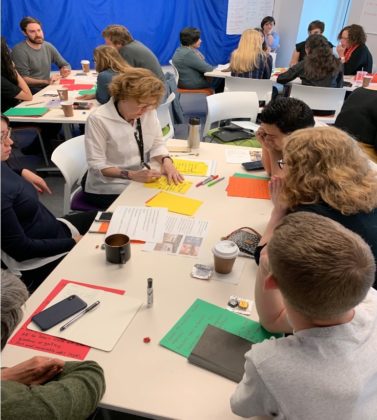
An Innovation Lab workshop at Cooper Hewitt. Photo courtesy Cooper Hewitt, Smithsonian Design Museum
“I came up with this idea of creating an research and development space specifically tasked with looking at visitor experience issues across the museum, and visitor experience in the broader sense, digital, physical, and human.
“You see R&D labs in museums, but they tend to be innovation labs, driven by technology, doing interesting work. They are often at the side, not integrated into the museum. They are hard to sustain as a model because at crunch times, like now, you would say, ‘Is this really critical to the mission and the priorities for the museum?’”
“I wanted to create an ‘interaction lab’: purposely not ‘innovation’, but ‘interaction’. The idea was to ask, how do we engage our visitors across these touchpoints? What are those interactions that we want to try to encourage? At what points do we want to do that?
“It is about considering visitor experience from a holistic view, rather than simply putting some more tech in the galleries. I decided that I really didn’t want to go that route. So, at the beginning of 2019, I created the Interaction Lab.”
Collaborations and partnerships
“Rachel Ginsberg helps me to run it and she comes from the experience design perspective. We spent most of last year working up a strategy for this lab, around partnerships.”
It is a lab without walls, says Royston:
“It’s not a physical space in the museum. We purposely did that, so that we could foster collaborations outside of the museum, and opportunities to work with anybody from a single designer to a big tech firm.
“Part of the project is about developing partnerships that will help us to experiment and prototype in R&D in ways that wouldn’t be possible on our own. Either from a skillset perspective or in terms of access to emerging technology or expertise.”
Another area is the Creative Commissioning Program:
“This is so that we could have small scale commissions that we can send out to different kinds of parties depending on what the project might be, whether that’s a designer, a tech firm or a digital agency, to experiment with different kinds of visitor experience ideas that may not all be digitally based.
“The idea of the commissions is to create a series of R&D experiences. Prototypes that we may then spin up into something on a larger scale for the museum, and that we would test with visitors. We would learn and iterate and, where we are successful, work further.”
Involving the public
The project also involves a public program, which has been running at Cooper Hewitt since last September:
“It is around what we are doing. It also speaks to the big, universal questions and challenges for museums. What are museums grappling with right now? What are we grappling with at Cooper Hewitt that we know other museums are as well?
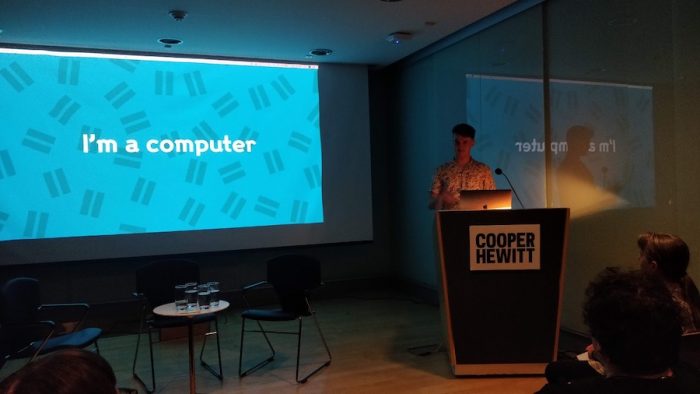
Public program on “Museums and Artificial Intelligence” at Cooper Hewitt, Smithsonian Design Museum. (Photo courtesy Cooper Hewitt)
“We designed the program to be how we want to run the lab, which is to make sure that the public programs weren’t just speakers on a stage presenting projects, and then people doing a Q and A. What we really wanted was to create sessions, programs that were genuinely participatory and collaborative.
“We not only tried to pick interesting topics and bring in people that aren’t necessarily from the museum sector, but to design the sessions to encourage people to go into the museum as part of the session, do some active exploration around the topics, and then come back together and share what they’ve learned.
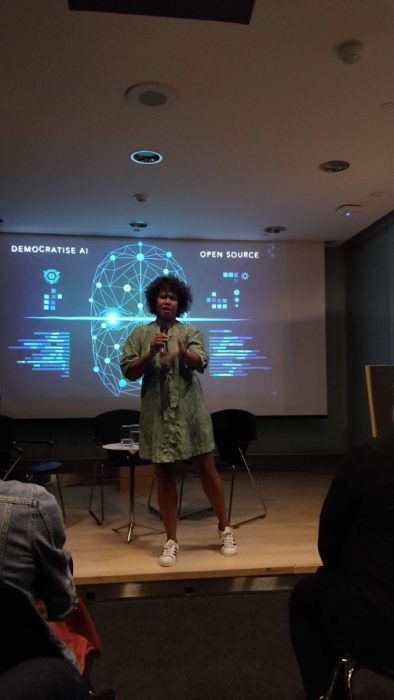
Public program on “Museums and Artificial Intelligence.” Photo courtesy Carolyn Royston
“The sessions range from one on AI, one on interaction and storytelling, one on body storming and access. For this session, we invited three disabled dancers to come in and to talk about their relationship to and experience of museums. They took the audience into the galleries and led activities in the museum.
“For that one, we kept the audience to 50; for the others, our capacity in the museum is just over a hundred. They were all sold out. One session was on information design and storytelling; another linked to architecture.”
New conversations
“How do you link together your stories and your collections to be able to present in interesting and new ways?” asks Royston.
“Each time, we had the people that were presenting do an introduction to the subject, and then take groups into the galleries to run activities with them. The response to it was unexpected. The people that were signing up to the event were museum professionals, designers, technologists, funding bodies.”
“It was extraordinary. The museum people were across a whole span of functions. From technologists to exhibition designers, to interpretation people, to marketing people.”
Carolyn Royston realized that these sessions were conversations that people across the board wanted to have and that they weren’t happening anywhere else:
“The cross-section and the cross-function was really interesting. I think we have had representation from every single museum across the New York area.”
And then the pandemic hit.
Pandemic as Portal
“We wanted to keep running our programs, but in the spirit of our in-person ones: how could we do the collaboration? How could we do the participation? How could we keep the spirit of the interaction lab? We were starting to get a little fan club. There were people who were coming to each one, wanting to know when the next would be.
“And there were people outside New York who were saying, ‘Oh, I wish you were streaming these.’ We hadn’t really got to that place, but suddenly we were in this online situation and we thought we should have a go at running one online, and see what happened.”

Participants in the “Pandemic as Portal” virtual conference at Cooper Hewitt, Smithsonian Design Museum. (Photo courtesy Cooper Hewitt)
The result was an event at the beginning of May called ‘Pandemic as Portal: Exploring the in-between’.
“It was based on an article that we had seen in the Financial Times. This was around the idea that we’re going to be leaving things behind and moving into this new normal, this new future. What are we going to take with us? And where are we going, what is going to look different for us, and as museum professionals, what does that look like?
“We had also been playing with Miro, an online collaborative tool that enables you to use it like a whiteboard. We decided to use that as our tool so that people could collaborate and participate.”
Designing the visitor experience
Nearly 200 people participated from 21 countries and 40 museums in the U.S.
“We ran this session where we had breakout groups, we asked some questions and we invited people to contribute through the board, which is now an artefact of the event. We got great feedback.
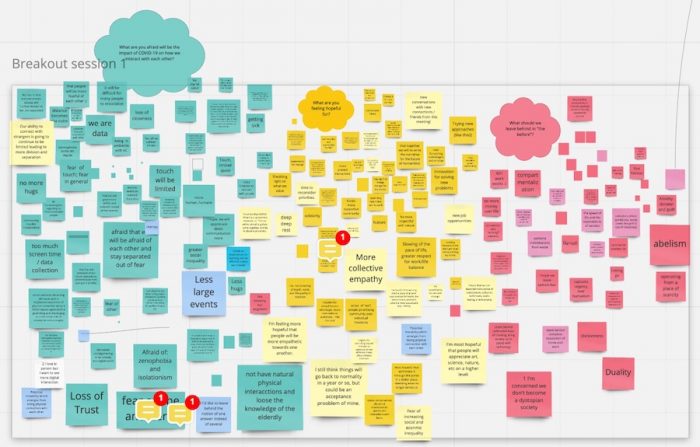
“Pandemic as Portal” breakout session. (Photo courtesy Cooper Hewitt)

“Pandemic as Portal” breakout session. (Photo courtesy Cooper Hewitt)
“It was a little bit chaotic, having 200 people use a collaborative tool. We learned how to better manage things. And also that onboarding people with a new piece of software is not simple. We’re planning to run another session as a partner to this one. Now we’re in this online environment, we want to build a program so that we’re having more regular sessions.”
The pandemic, Royston feels, will also accelerate trends that were already beginning to be perceptible for some time.
“Having more of a diversified revenue stream is one consideration,” she says. “Besides just the café and shop, what other opportunities are out there, in the digital space, to think about in terms of content or experiences or an offer that could be chargeable? What would that look like?”
“Is there an opportunity to develop digital membership, and more of these subscription models that we’re seeing with industries like Netflix? How can museums adapt to more of a digital-first environment? Although we’re opening again, we’re opening to much smaller numbers. We need to consider what the experience looks like in a museum in a physical space now, and how we adapt.”
Engaging audiences
The Pandemic as Portal session at Cooper Hewitt is an example of how digital can draw an audience of 200 people from across the world together to share their ideas.
“There are 6,000 employees at the Smithsonian,” says Carolyn Royston. “In our public program, when we came back together from our breakout groups, one person spoke up and said, ‘I work at the Smithsonian in Washington. I’ve just been in a breakout group with another person from the Smithsonian who I’d never met before and had an opportunity to talk to.’”
Even within our own organization, the digital environment affords new ways of communicating, different ways of interacting, and new opportunities.
“Even within our own organization, the digital environment affords new ways of communicating, different ways of interacting, and new opportunities.
“They’re not better than in-person; they’re just different. So how do we take the normal models of programming, where you have speakers who come in, and people come and listen to them.
“What can we do that might be different? Or what can we do if people can’t visit? What does being a virtual tourist look like? How would we want a virtual tourist to experience Cooper Hewitt? What does a virtual school trip look like? We need to establish the ways in which we can bring Cooper Hewitt to life in a virtual space. One that isn’t trying to replace a physical visit, but is using the digital environment to enhance the experience.”

“Pandemic as Portal” session using the Miro interactive tool. (Photo courtesy Cooper Hewitt.
Adjusting to the new normal
Without question, Royston says, the current situation is opening up interesting possibilities. However:
“It’s all still so new. Even though it feels like it’s been forever, it has really been hardly any time at all. What happens when we reopen to the public? What might it look like six months, a year, or two years from now?
“I think we’ll continue to evolve and look different. As museums, we just can’t carry on in the way that we have. There is a new normal. Each institution needs to figure out what that new normal looks like. Both in terms of the logistics and the operational side.”
“On the visitor experience side, and also organizationally, where do we need to make changes? Where do we need to be thinking in different ways? Where do we need to be supporting staff, in terms of having the skills to be able to work in these new ways?
“Everybody has had to adapt to working in this online environment, using Zoom, using Skype, using Microsoft Teams. What does that mean when we translate it into the visitor experience? And what are the things that we should be not just offering, but now building into our programmatic work?
“We will have some people on site. But there needs to be a recognition that visitation is likely to be small for a long time. Particularly in cities where tourism is huge. How do we build and develop an online program in a strategic way?”
International reach
One interesting development has been a big increase in Cooper Hewitt’s international reach.
“Again, just like the Pandemic is Portal event, suddenly Cooper Hewitt also has an opportunity to reach a much wider audience. Essentially, what we have to understand is: what is our value, and what are our values? We need to establish how we position ourselves to focus on the things that matter.”
This is an edited version of an article originally published by Blooloop. Republished with permission.
 Lalla Merlin studied English at St. Hugh’s College, Oxford University. A writer and film-maker, she lives in rural Devon with husband, children, and an assortment of badly-behaved animals, including an enormous wolf.
Lalla Merlin studied English at St. Hugh’s College, Oxford University. A writer and film-maker, she lives in rural Devon with husband, children, and an assortment of badly-behaved animals, including an enormous wolf.
Posted: 22 September 2020
-
Categories:
Art and Design , Cooper Hewitt Museum , Education, Access & Outreach , Feature Stories
